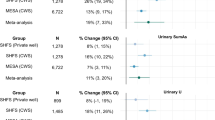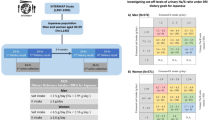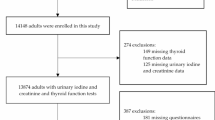Abstract
Background
American Indian (AI) communities are affected by uranium exposure from abandoned mines and naturally contaminated drinking water. Few studies have evaluated geographical differences across AI communities and the role of dietary exposures.
Objective
We evaluated differences in urinary uranium levels by diet and geographical area among AI participants from the Northern Plains, the Southern Plains, and the Southwest enrolled in the Strong Heart Family Study (SHFS).
Methods
We used food frequency questionnaires to determine dietary sources related to urinary uranium levels for 1,682 SHFS participants in 2001–2003. We calculated adjusted geometric mean ratios (GMRs) of urinary uranium for an interquartile range (IQR) increase in self-reported food group consumption accounting for family clustering and adjusting for sociodemographic variables and other food groups. We determined the percentage of variability in urinary uranium explained by diet.
Results
Median (IQR) urinary uranium levels were 0.027 (0.012, 0.057) μg/g creatinine. Urinary uranium levels were higher in Arizona (median 0.039 μg/g) and North Dakota and South Dakota (median 0.038 μg/g) and lower in Oklahoma (median 0.019 μg/g). The adjusted percent increase (95% confidence interval) of urinary uranium levels per IQR increase in reported food intake was 20% (5%, 36%) for organ meat, 11% (1%, 23%) for cereals, and 14% (1%, 29%) for alcoholic drinks. In analyses stratified by study center, the association with organ meat was specific to North Dakota and South Dakota participants. An IQR increase in consumption of fries and chips was inversely associated with urinary uranium levels −11% (−19%, −3%). Overall, we estimated that self-reported dietary exposures explained 1.71% of variability in urine uranium levels.
Impact
Our paper provides a novel assessment of self-reported food intake and urinary uranium levels in a cohort of American Indian participants. We identify foods (organ meat, cereals, and alcohol) positively associated with urinary uranium levels, find that organ meat consumption is only associated with urine uranium in North Dakota and South Dakota, and estimate that diet explains relatively little variation in total urinary uranium concentrations. Our findings contribute meaningful data toward a more comprehensive estimation of uranium exposure among Native American communities and support the need for high-quality assessments of water and dust uranium exposures in SHFS communities.
This is a preview of subscription content, access via your institution
Access options
Subscribe to this journal
Receive 6 print issues and online access
$259.00 per year
only $43.17 per issue
Buy this article
- Purchase on SpringerLink
- Instant access to full article PDF
Prices may be subject to local taxes which are calculated during checkout



Similar content being viewed by others
Data availability
Strong Heart Study data is owned by the participating tribes and is not available for public use. Investigators interested in accessing Strong Heart Study data can follow the procedures put in place by the Strong Heart Study Steering committee in agreement with the participating tribes (see www.strongheartstudy.org).
References
Shelley R, Kim NS, Parsons PJ, Lee BK, Agnew J, Jaar BG, et al. Uranium associations with kidney outcomes vary by urine concentration adjustment method. J Expo Sci Environ Epidemiol. 2014;24:58–64.
Pang Y, Peng RD, Jones MR, Francesconi KA, Goessler W, Howard BV, et al. Metal mixtures in urban and rural populations in the US: The Multi-Ethnic Study of Atherosclerosis and the Strong Heart Study. Environ Res. 2016;147:356–64.
Keith LS, Faroon OM, Fowler BA. CHAPTER 45 - Uranium. In: Nordberg GF, Fowler BA, Nordberg M, Friberg LT, editors. Handbook on the toxicology of metals. 3rd ed. Burlington: Academic Press; 2007. p. 881–903. https://www.sciencedirect.com/science/article/pii/B9780123694133501002
Ingram JC, Jones L, Credo J, Rock T. Uranium and arsenic unregulated water issues on Navajo lands. J Vac Sci Technol A. 2020;38:031003.
Ravalli F, Yu Y, Bostick BC, Chillrud SN, Schilling K, Basu A, et al. Sociodemographic inequalities in uranium and other metals in community water systems across the USA, 2006–11: a cross-sectional study. Lancet Planet Health. 2022;6:e320–30.
Keith LS, Faroon OM, Fowler BA. Chapter 59 - Uranium. In: Nordberg GF, Fowler BA, Nordberg M, editors. Handbook on the toxicology of metals. 4th ed. San Diego: Academic Press; 2015. p. 1307–45. https://www.sciencedirect.com/science/article/pii/B9780444594532000597
ATSDR. Toxicological profile for uranium. Public Health Statement for Uranium; 2013. https://wwwn.cdc.gov/TSP/PHS/PHS.aspx?phsid=438&toxid=77
Dreesen DR, Williams JM, Marple ML, Gladney ES, Perrin DR. Mobility and bioavailability of uranium mill tailings contaminants. Environ Sci Technol. 1982;16:702–9.
Keith LS, Faroon O, Roney N, Scinicariello F, Wilbur S, Ingerman L, et al. Potential for human exposure. Toxicological Profile for Uranium. Agency for Toxic Substances and Disease Registry (US); 2013. https://www.ncbi.nlm.nih.gov/books/NBK158799/
Sheppard MI, Vandergraaf TT, Thibault DH, Reid JA. Technetium and uranium: sorption by and plant uptake from peat and sand. Health Phys. 1983;44:635–43.
Lapham SC, Millard JB, Samet JM. Health implications of radionuclide levels in cattle raised near U mining and milling facilities in Ambrosia Lake, New Mexico. Health Phys. 1989;56:327–40.
Thomas P, Irvine J, Lyster J, Beaulieu R. Radionuclides and trace metals in Canadian moose near uranium mines: comparison of radiation doses and food chain transfer with cattle and caribou. Health Phys. 2005;88:423–38.
Environmental Protection Agency (EPA). Drinking water criteria document for uranium. Report No.: PB86241049. Washington, DC: U.S. Environmental Protection Agency; 1985.
Centers for Disease Control and Prevention (CDC). National report on human exposure to environmental chemicals. Hyattsville, MD: U.S. Department of Health and Human Services, Centers for Disease Control and Prevention; 2022. https://www.cdc.gov/exposurereport/index.html
Lee ET, Welty TK, Fabsitz R, Cowan LD, Le NA, Oopik AJ, et al. The Strong Heart Study. A study of cardiovascular disease in American Indians: design and methods. Am J Epidemiol. 1990;132:1141–55.
North KE, Howard BV, Welty TK, Best LG, Lee ET, Yeh JL, et al. Genetic and environmental contributions to cardiovascular disease risk in American Indians: the strong heart family study. Am J Epidemiol. 2003;157:303–14.
Eilat-Adar S, Mete M, Fretts A, Fabsitz R, Handeland V, Lee E, et al. Dietary patterns and their association with cardiovascular risk factors in a population undergoing lifestyle changes: the strong heart study. Nutr Metab Cardiovasc Dis. 2013;23:528–35.
Block G, Subar AF. Estimates of nutrient intake from a food frequency questionnaire: the 1987 National Health Interview Survey. J Am Diet Assoc. 1992;92:969–77.
Fretts AM, Howard BV, McKnight B, Duncan GE, Beresford SA, Mete M, et al. Associations of processed meat and unprocessed red meat intake with incident diabetes: the Strong Heart Family Study1234. Am J Clin Nutr. 2012;95:752–8.
Subar AF, Thompson FE, Kipnis V, Midthune D, Hurwitz P, McNutt S, et al. Comparative validation of the Block, Willett, and National Cancer Institute food frequency questionnaires: the Eating at America’s Table Study. Am J Epidemiol. 2001;154:1089–99.
Block G, Wakimoto P, Block T. A revision of the Block Dietary Questionnaire and database, based on NHANES III data. Berkeley Univ Calif Berkeley; 1998. p. 5
Nigra AE, Olmedo P, Grau-Perez M, O’Leary R, O’Leary M, Fretts AM, et al. Dietary determinants of inorganic arsenic exposure in the Strong Heart Family Study. Environ Res. 2019;177:108616.
Olmedo P, Grau-Perez M, Fretts A, Tellez-Plaza M, Gil F, Yeh F, et al. Dietary determinants of cadmium exposure in the Strong Heart Family Study. Food Chem Toxicol Int J Publ Br Ind Biol Res Assoc. 2017;100:239–46.
United States Food and Drug Administration. Total Diet Study: Elements results summary statistics, market baskets 2006 through 2011. 2014. http://www.fda.gov/downloads/Food/FoodScienceResearch/TotalDietStudy/UCM184301.pdf
Scheer J, Findenig S, Goessler W, Francesconi KA, Howard B, Umans JG, et al. Arsenic species and selected metals in human urine: validation of HPLC/ICPMS and ICPMS procedures for a long-term population-based epidemiological study. Anal Methods Adv Methods Appl. 2012;4:406–13.
Strong Heart Steering Committee. Phase IV Operations Manual. Volume II: Morbidity and mortality surveillance procedures. 2001. https://strongheartstudy.org/portals/1288/Assets/documents/manuals/Phase%20IV%20Operations%20Manual.pdf?ver=2017-11-15-134610-080
Choi G, Buckley JP, Kuiper JR, Keil AP. Log-transformation of Independent Variables: Must We? Epidemiol Camb Mass. 2022;33:843–53.
Dashner-Titus EJ, Hoover J, Luo L, Lee JH, Du R, Liu KJ, et al. Metal exposure and oxidative stress markers in pregnant Navajo Birth Cohort Study participants. Free Radic Biol Med. 2018;124:484–92.
Scammell MK, Sennett C, Laws RL, Rubin RL, Brooks DR, Amador JJ, et al. Urinary metals concentrations and biomarkers of autoimmunity among navajo and nicaraguan men. Int J Environ Res Public Health. 2020;17:E5263.
O’Brien KM, Upson K, Cook NR, Weinberg CR. Environmental chemicals in urine and blood: improving methods for creatinine and lipid adjustment. Environ Health Perspect. 2016;124:220–7.
Abuawad A, Goldsmith J, Herbstman JB, Parvez F, Islam T, LoIacono N, et al. Urine dilution correction methods utilizing urine creatinine or specific gravity in arsenic analyses: comparisons to blood and water arsenic in the FACT and FOX studies in Bangladesh. Water. 2022;14:1477.
Neves MO, Abreu MM, Figueiredo V. Uranium in vegetable foodstuffs: should residents near the Cunha Baixa uranium mine site (Central Northern Portugal) be concerned? Environ Geochem Health. 2012;34:181–9.
Rock T, Camplain R, Teufel-Shone NI, Ingram JC. Traditional sheep consumption by navajo people in Cameron, Arizona. Int J Environ Res Public Health. 2019;16:4195.
Bellés M, Linares V, Perelló G, Domingo JL. Human dietary exposure to Uranium in Catalonia, Spain. Biol Trace Elem Res. 2013;152:1–8.
Neves O, Abreu MM. Are uranium-contaminated soil and irrigation water a risk for human vegetables consumers? A study case with Solanum tuberosum L., Phaseolus vulgaris L. and Lactuca sativa L. Ecotoxicology. 2009;18:1130–6.
Bersamin A, Luick BR, King IB, Stern JS, Zidenberg-Cherr S. Westernizing diets influence fat intake, red blood cell fatty acid composition, and health in remote alaskan native communities in the center for Alaska native health study. J Am Diet Assoc. 2008;108:266–73.
Kauffman SAE, Averill MM, Delaney JAC, Lemaitre RN, Howard BV, Fretts AM. Associations of diet quality and blood serum lipoprotein levels in a population at high risk for diabetes: the strong heart family study. Eur J Clin Nutr. 2020;74:1084–90.
Jernigan VBB, Nguyen CJ, Maudrie TL, Demientieff LX, Black JC, Mortenson R, et al. Food sovereignty and health: a conceptual framework to advance research and practice. Health Promot Pr. 2023;24:1070–4.
Jernigan VBB, Williams M, Wetherill M, Taniguchi T, Jacob T, Cannady T, et al. Using community-based participatory research to develop healthy retail strategies in Native American-owned convenience stores: The THRIVE study. Prev Med Rep. 2018;11:148–53.
Blue Bird Jernigan V, Salvatore AL, Styne DM, Winkleby M. Addressing food insecurity in a Native American reservation using community-based participatory research. Health Educ Res. 2012;27:645–55.
Hao Z, Li Y, Li H, Wei B, Liao X, Liang T, et al. Levels of rare earth elements, heavy metals and uranium in a population living in Baiyun Obo, Inner Mongolia, China: A pilot study. Chemosphere. 2015;128:161–70.
Pearson AJ, Ashmore E. Risk assessment of antimony, barium, beryllium, boron, bromine, lithium, nickel, strontium, thallium and uranium concentrations in the New Zealand diet. Food Addit Contam Part A. 2020;37:451–64.
De La Rosa VY, Hoover J, Du R, Jimenez EY, MacKenzie D, Lewis J. Diet quality among pregnant women in the Navajo Birth Cohort Study. Matern Child Nutr. 2020;16:e12961.
Sharma S, Yacavone M, Cao X, Pardilla M, Qi M, Gittelsohn J. Dietary intake and development of a quantitative FFQ for a nutritional intervention to reduce the risk of chronic disease in the Navajo Nation. Public Health Nutr. 2010;13:350–9.
ATSDR. Toxicological profile for uranium. Agency for Toxic Substances and Disease Registry; 2013. p. 526.
US EPA O. Radionuclides Rule. 2015. https://www.epa.gov/dwreginfo/radionuclides-rule
Hoover J, Gonzales M, Shuey C, Barney Y, Lewis J. Elevated arsenic and uranium concentrations in unregulated water sources on the Navajo Nation, USA. Expo Health. 2017;9:113–24.
US EPA O. Providing safe drinking water in America: National public water systems compliance report. 2014. https://www.epa.gov/compliance/providing-safe-drinking-water-america-national-public-water-systems-compliance-report
US EPA O. EPA’s role in safe drinking water on tribal lands. 2021. https://www.epa.gov/tribaldrinkingwater/epas-role-safe-drinking-water-tribal-lands-1
IAEA. Criteria for radionuclide activity concentrations for food and drinking water. Vienna: International Atomic Energy Agency; 2016. https://www.iaea.org/publications/11061/criteria-for-radionuclide-activity-concentrations-for-food-and-drinking-water
Lewis J, Hoover J, MacKenzie D. Mining and environmental health disparities in native american communities. Curr Environ Health Rep. 2017;4:130–41.
NHANES 2003-2004: Metals - Urine Data Documentation, Codebook, and Frequencies. 2023. https://wwwn.cdc.gov/nchs/nhanes/2003-2004/L06HM_C.htm
Acknowledgements
We thank all the Strong Heart Study participants and Tribal Nations that make this research possible.
Funding
The Strong Heart Study was supported by grants from the National Heart, Lung, and Blood Institute contracts 75N92019D00027, 75N92019D00028, 75N92019D00029, and 75N92019D00030; previous grants R01HL090863, R01HL109315, R01HL109301, R01HL109284, R01HL109282, and R01HL109319; and cooperative agreements U01HL41642, U01HL41652, U01HL41654, U01HL65520, and U01HL65521; and by National Institute of Environmental Health Sciences grants R01ES021367, R01ES025216, R01ES032638, P42ES033719, and P30ES009089. Kevin Patterson is also supported by III.
Author information
Authors and Affiliations
Contributions
KP, AN, and AN-A conceived and designed the study. KP performed the statistical analysis and drafted the initial manuscript. PO and MG-P supported the statistical analysis. PO, MG-P, RO, MO, AF, JU, LB, WG, SC contributed to literature collection, manuscript writing, and editing. AN, AN-A, and SC were responsible for the project’s conceptualization, supervising the project, data interpretation, and manuscript writing and editing.
Corresponding author
Ethics declarations
Competing interests
The authors declare no competing interests.
Ethical approval and consent to participate
Informed consent was obtained from all participants. Study protocol was approved by the Indian Health Service institutional review board (IRB) of each area, IRBs of participating institutions, and participating tribes.
Additional information
Publisher’s note Springer Nature remains neutral with regard to jurisdictional claims in published maps and institutional affiliations.
Supplementary Information
Rights and permissions
Springer Nature or its licensor (e.g. a society or other partner) holds exclusive rights to this article under a publishing agreement with the author(s) or other rightsholder(s); author self-archiving of the accepted manuscript version of this article is solely governed by the terms of such publishing agreement and applicable law.
About this article
Cite this article
Patterson, K.P., Nigra, A.E., Olmedo, P. et al. Geographic and dietary differences of urinary uranium levels in the Strong Heart Family Study. J Expo Sci Environ Epidemiol 35, 393–402 (2025). https://doi.org/10.1038/s41370-024-00695-6
Received:
Revised:
Accepted:
Published:
Issue date:
DOI: https://doi.org/10.1038/s41370-024-00695-6



